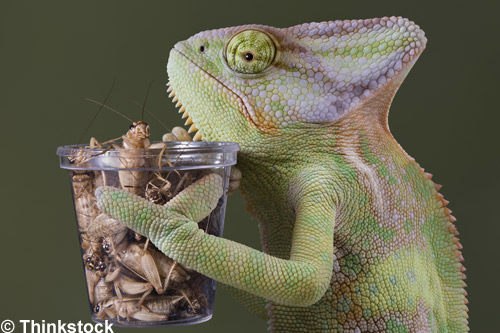Bonus content from the July 2011 REPTILES magazine article "Exotic Offerings."
Maintaining Feeder Cockroaches
Cockroaches are undoubtedly one of the easiest feeder species to maintain in captivity for feeding reptiles, often thriving on benign neglect. A large Sterilite or Rubbermaid bin makes an excellent rearing container. We drill holes in the lid with a 3-inch hole saw, and then cover these holes with aluminum window screening to prevent escape.
For glass-climbing cockroach species, we maintain a 3-inch strip of Vaseline or a “roach barrier” around the upper portion of the enclosure. Roach barrier products are easier to maintain than Vaseline, as petroleum jelly will run down the enclosure’s sides when heat and humidity build, thus requiring frequent reapplication.

If you have a large number of herps, you might try raising your own crickets, but for one or two herp pets, it is more convenient to just purchase them from a breeder
For feeder cockroach substrate, use coco coir. It will maintain a low-level humidity at the bottom, which will promote cockroach molting and prevent desiccation. Egg crate is stacked vertically in the bins to increase surface area and allow the cockroaches to feel secure in their environment.
We feed the cockroaches a wide variety of dry foods, including wheat bran, oats, puppy food and commercial gut-load products. Many people provide moisture in the form of gels marketed for this purpose, but we prefer to offer a wide variety of organic fruits and vegetables. We feed carrots, apples, pears, nectarines, spring mix, zucchini and yellow squash.
Cockroaches have proven very rewarding feeders for us. Rearing the species mentioned is cost-effective, and most insectivores will enjoy feeding on these often-soft-bodied insects.
How to Raise Feeder Crickets
Raising feeder crickets in captivity can be extremely difficult. Temperatures needed to successfully raise them must be in the high-80 degrees Fahrenheit. Adjusting temperatures can control the growth rate of pinhead crickets. Keeping a four-week old cricket at 80 degrees will slow their growth.
Crickets should be maintained in well-ventilated cages. A trash can works, but may require a ventilated lid to prevent escapes. Provide clean food and water at all times. A good strategy is to keep a moist natural sponge in the cage, and rinse it every few days. Feeding crickets is also an important parameter to proper growth and development. We have used a base of Layena chicken scratch augmented with a variety of vegetables. It works very well as a cricket diet. Red-leaf lettuce, romaine lettuce, collard greens, grated carrots, grated yellow squash and other vegetables are good sources of nutrition for crickets. Keep in mind that a nutritious diet for the cricket translates to a nutritious meal for the animal feeding upon that cricket.
The actual breeding of crickets is straightforward. However, the single greatest challenge to raising feeder crickets is to get them to grow past two weeks of age. A substrate of coconut fiber is good for ovipositing sites. The cricket eggs must be maintained on a moist substrate, but do not allow the nesting container to become soggy. Once the baby crickets, or pinheads, start to grow, they should be separated into smaller groups. Overcrowding is detrimental to the overall health of the cricket colony.
Raising crickets is a daunting task. It takes a tremendous amount of time to oversee the successful production of crickets. During the summer of 2010, a virus infected many cricket colonies in the United States. It took a lot of effort to establish new strains of crickets that were either not infected with the virus or had developed resistance to the virus. In many ways, it is much easier to pay $20 to have a thousand crickets delivered to your doorstep than it is to raise the crickets yourself.
Want to read the full story? Pick up the July 2011 issue of REPTILES, or subscribe to get 12 months of articles just like this.


